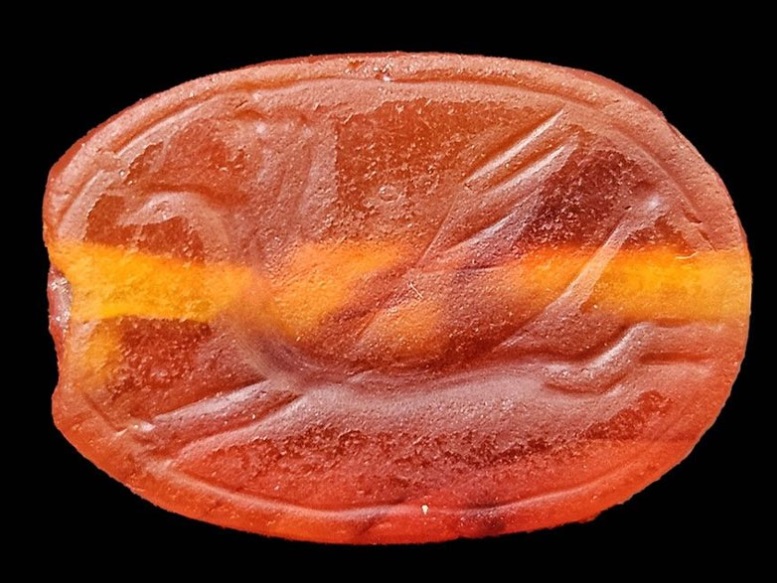
A 2,800-year-old engraved stone known as a ‘scarab,’ depicting a griffin, has been found by a hiker on military leave in Israel’s Tabor Stream Nature Reserve. Experts claim it is linked to the ancient Assyrian period of rule in the region.
Erez Avrahamov, 45, discovered the scarab, a thumbnail-sized orange amulet, during a leisurely hike in the Lower Galilee, Israel in early February.
“I had a two-day leave from the military and decided to take advantage of the sunny days for a trip,” Avrahamov is reported to have said in a press release from Israel’s Ministry of Foreign Affairs.
מטייל גילה קמע חרפושית המתוארך לתקופת הבית הראשון, בשמורת טבע נחל תבור שבגליל התחתון >>
ניר דיסטלפלד, מפקח היחידה למניעת שוד ברשות העתיקות, "אמרתי לו שיסתכל על הצד השני ויבדוק אם מופיעה עליו חריתה. מיד שמעתי בטלפון קריאות התפעלות"לפוסט המלא: https://t.co/KjzAi32DeJ pic.twitter.com/PfZKnmPJfg
— רשות העתיקות – Israel Antiquities Authority (@AntiquitiesIL) February 7, 2024
“During the trip, I saw something sparkling on the ground,” Avrahamov said. “At first, I thought it was a bead or an orange stone. After picking it up, I noticed engravings on it resembling a scarab. I contacted and reported the amazing find to the Israel Antiquities Authority.”
Nir Distelfeld of the Theft Prevention Unit at the Israel Antiquities Authority reportedly requested that Avrahamov inspect the flat side of the scarab to see if it was engraved.
“Immediately I heard an exclamation of amazement over the phone, and he reported to me that he identified a figure.”
Further examination carried out at the University of Fribourg in Switzerland revealed that the scarab, made from carnelian, bore the image of a griffin galloping. This was characteristic of artistic displays from the eighth century BC.
“We thank Erez, who showed good citizenship and delivered the rare scarab to the national treasures of the Israel Antiquities Authority,” said Distelfeld. “We awarded him a certificate on behalf of the Israel Antiquities Authority for demonstrating exemplary citizenship. Such a rare find can certainly expand our knowledge of the past.”
Distelfeld added that “the beautiful scarab was found at the foot of Tel Rekhesh, one of the important tel sites in the north of the country. The site is identified as the city of ‘Anacharath’ (Joshua 19:19) within the territory of the tribe of Issachar.”
A type of seal common throughout the region from around the fourth millennium BC, the scarab, researchers claim, is a valuable artifact for understanding ancient civilizations.
The Scarab Found in Israel May Indicate Presence of Assyrian Officials
Yitzhak Paz, an archaeologist at the Israel Antiquities Authority, remarked on the significance of the scarab being found in Tel Rekhesh, an ancient historic site associated with the city of Anacharath, mentioned in the Bible.

“The scarab may be from the period of the Assyrian rule and may indicate the presence of Assyrian officials (or perhaps Babylonian) at Tel Rekhesh during this period,” the press release quotes Paz as saying. “The griffin appearing on the seal is a known artistic motif in Ancient Near Eastern art and is common on seals from the Iron Age.”
He added, “If indeed the seal can be dated to the late Iron Age based on iconographic considerations, it may be possible to link the seal to the Assyrian presence in the citadel of Tel Rekhesh, which may be a discovery of great significance.”
Director of the Israeli Antiquities Authority Eli Escusido said the special scarab will be preserved in the IAA’s national treasures department for further research and to determine if it is indeed from the Assyrian period, according to the press release.
“Every winter, with the arrival of the rainy season in Israel, antiquities, such as scarabs, begin to ‘float’ and rise above the surface,” he said. “I urge the public to adhere to the Antiquities Law and ask that if you come across an archaeological find, report it to the Israel Antiquities Authority immediately from the site. The exact place of discovery is crucial for extracting knowledge about it.”
Scarabs were also widely popular throughout ancient Egypt and still survive in large numbers today. Through their inscriptions and typology, they prove to be a useful source of information for archaeologists and historians, representing a sizeable portion of ancient Egyptian art.
See all the latest news from Greece and the world at Greekreporter.com. Contact our newsroom to report an update or send your story, photos and videos. Follow GR on Google News and subscribe here to our daily email!



